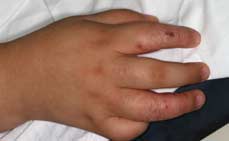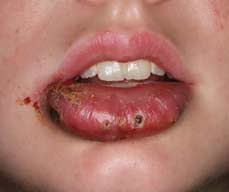3-year-old female presents with black lesions on mouth
Click Here to Manage Email Alerts


A previously healthy 3-year-old female was admitted to the hospital with dehydration caused by poor oral intake due to painful sores in her mouth and on her lips. She also has a black lesion covering most of her upper lip and philtrum area (Figure 1). The problem began 4 days prior to admission, when the mother noted the presence of a few “pimples” above the upper lip. Soon, the lesions spread to include her oral mucosa and lower lip, along with some surrounding skin. Two days after the onset, she was taken to an urgent care clinic, where she was prescribed acyclovir for a presumed herpes simplex virus (HSV) infection. Two days later (day 4), she seemed to be much worse, particularly regarding dehydration, and was sent for admission.

Her past medical history is positive only for moderately severe eczema and mild intermittent asthma. She has had no sick contacts, but her family history includes her father having frequent cold sores, and he had recovered from one recently. Her immunizations are up to date.
Examination was that of a healthy but fairly uncomfortable-appearing 3-year-old female who had normal vital signs. However, it was noted that she had subjective fever at home. The only abnormal findings included the eschar-appearing lesion covering the upper lip and philtrum, along with some oral ulcers and numerous, small papulopustular lesions, as well as some small dry scabs about the rest of the face and eyelids (Figure 2). The conjunctivae were clear. Additionally, there were widely scattered, similar-appearing lesions on the extremities, particularly the right hand (Figure 3). A blood culture was obtained as well as a bacterial culture, along with a swab for HSV PCR of the lip lesion, and the patient started therapy with clindamycin, ceftriaxone and acyclovir.

What’s your diagnosis?
A. Staphylococcus aureus cellulitis
B. Atypical hand-foot-and-mouth syndrome
C. Eczema herpeticum
D. Atypical Stevens-Johnson syndrome

This is a somewhat unusual case of eczema herpeticum (choice C). The oldest lesions occurred on the upper lip and philtrum area, with resultant spread and crust formation resembling a large black eschar. The lesions on her fingers were likely transferred from her mouth lesions. The oral lesions were fairly typical, but the surrounding cutaneous lesions appeared somewhat smaller than one would usually see with this condition, as noted in a similar patient shown in Figure 4.

The PCR was positive for HSV-1, and she was discharged on hospital day 4 on oral acyclovir. Some felt the need for clindamycin as well for an additional week due to her underlying eczema, which seemed reasonable, as Staphylococcus aureus is often abundantly present in eczematous lesions and may contribute to further injury.

Staphylococcal cellulitis of the lip is unusual but not unheard of, as shown in figure 5. In that case, the patient had MRSA cellulitis of the lower lip with abcess requiring drainage. The port of entry was unclear.
Atypical Stevens-Johnson syndrome is increasingly being recognized, and it is most likely triggered by a Mycoplasma infection with very similar mucous membrane features as typical Stevens-Johnson syndrome, but with very little to no cutaneous involvement (Figure 6).

Atypical hand-foot-and-mouth syndrome was first recognized several years ago, most likely due to Coxsackievirus A6. This can usually be diagnosed by obtaining an enterovirus PCR of one of the lesions or a rectal swab. It differs from typical hand-foot-and-mouth syndrome, which is usually caused by Coxsackievirus A16, by usually being more severe and widespread (Figure 7), and tending to occur in older children and even adults, and during the winter months. These patients are often sick, and due to the uncertainty of diagnosis, they are frequently admitted to the hospital.
Columnist Comments: This year’s seasonal influenza vaccine should be out soon. Don’t forget to take it yourself; if not for yourself, take it to protect your patients from exposure.
- For more information:
- James H. Brien, DO, is with the department of infectious diseases at McLane Children’s Hospital, Baylor Scott & White Health, and an adjunct professor of pediatrics at Texas A&M College of Medicine in Temple, Texas. He also is a member of the Infectious Diseases in Children Editorial Board. Brien can be reached at jhbrien@aol.com.
Disclosure: Brien reports no relevant financial disclosures.
